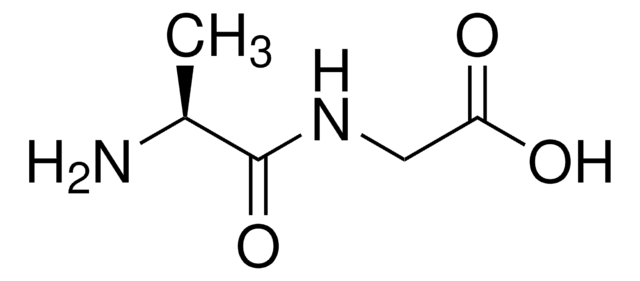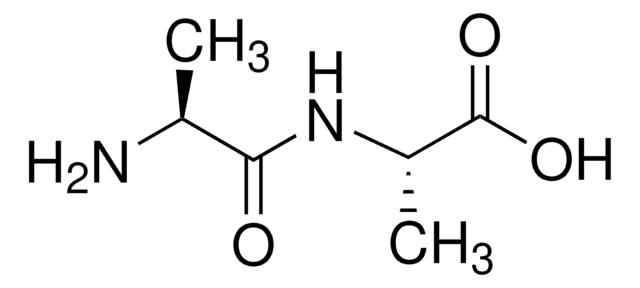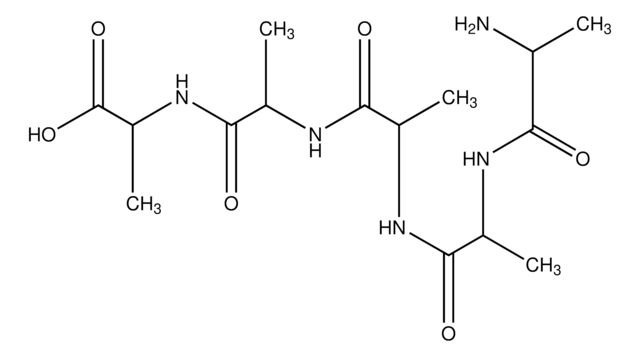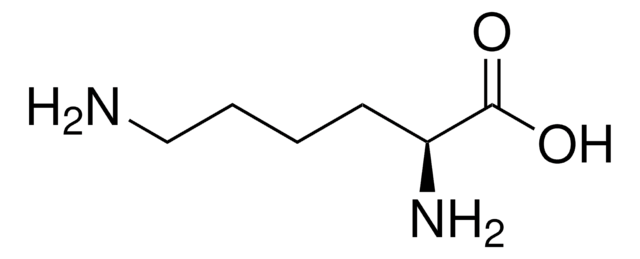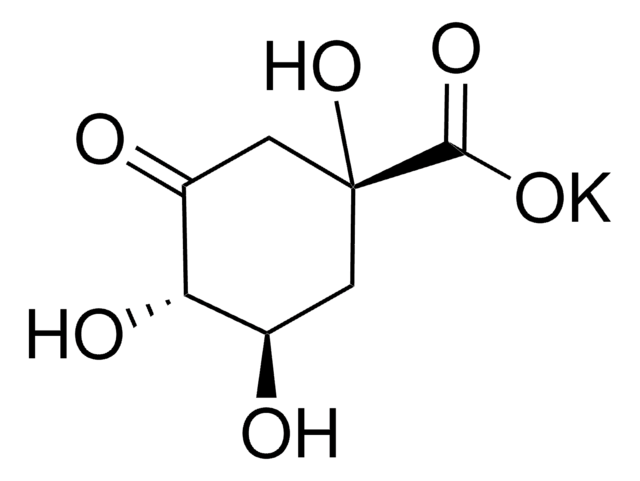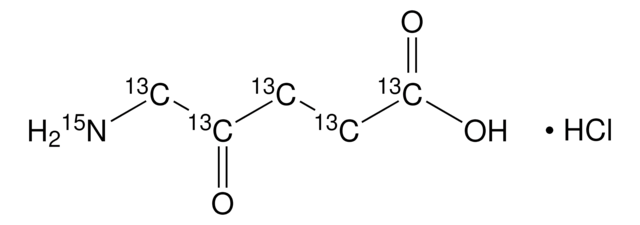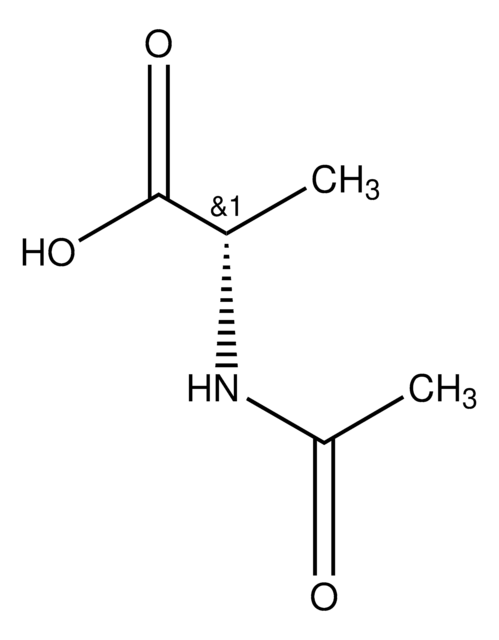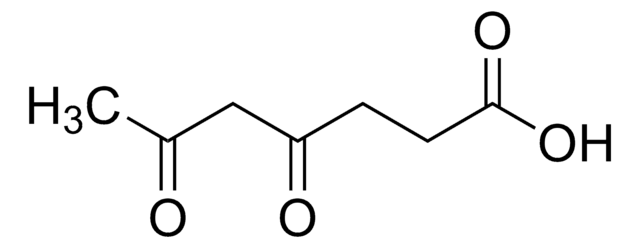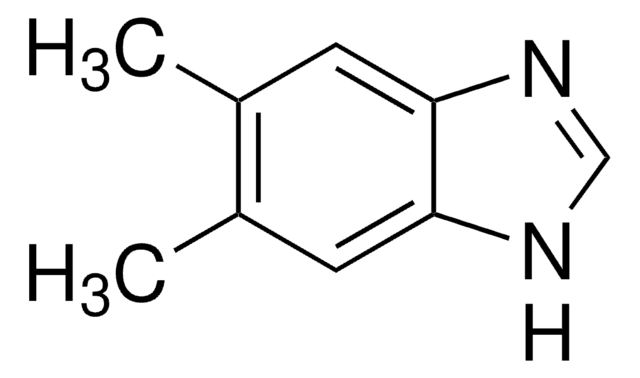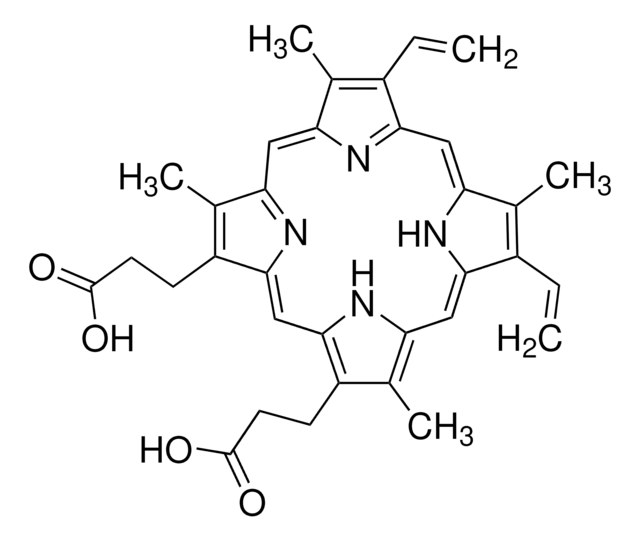A7793
5-Aminolevulinic acid hydrochloride
BioReagent, suitable for cell culture, powder, ≥98%
Synonym(s):
δ-Aminolevulinic acid hydrochloride, 5-Amino-4-oxopentanoic acid hydrochloride, 5-Aminolaevulinic acid hydrochloride, ALA
Sign Into View Organizational & Contract Pricing
All Photos(3)
About This Item
Linear Formula:
NH2CH2C(O)CH2CH2COOH · HCl
CAS Number:
Molecular Weight:
167.59
Beilstein:
3690651
EC Number:
MDL number:
UNSPSC Code:
12352209
PubChem Substance ID:
NACRES:
NA.75
Recommended Products
product line
BioReagent
Quality Level
Assay
≥98%
form
powder
technique(s)
cell culture | mammalian: suitable
solubility
H2O: 50 mg/mL
storage temp.
−20°C
SMILES string
Cl[H].NCC(=O)CCC(O)=O
InChI
1S/C5H9NO3.ClH/c6-3-4(7)1-2-5(8)9;/h1-3,6H2,(H,8,9);1H
InChI key
ZLHFONARZHCSET-UHFFFAOYSA-N
Looking for similar products? Visit Product Comparison Guide
Application
5-Aminolevulinic acid formed from glycine and succinyl CoA by ALA synthase is the first compound in prophyrin biosynthesis pathway. 5-Aminolevulinic acid is used in photodynamic therapy. This compound may be used to study the effects of photodynamic therapy in vitro.
Biochem/physiol Actions
Intermediate in heme biosynthesis.
Storage Class Code
11 - Combustible Solids
WGK
WGK 3
Flash Point(F)
Not applicable
Flash Point(C)
Not applicable
Choose from one of the most recent versions:
Already Own This Product?
Find documentation for the products that you have recently purchased in the Document Library.
Customers Also Viewed
Firas Şueki et al.
Photodiagnosis and photodynamic therapy, 27, 95-99 (2019-05-18)
Photodynamic Therapy (PDT) is a promising antitumor and anti-bacterial treatment method for its high selectivity, non-invasiveness, and minimal side effects. However, cellular mechanisms may lead to PDT resistance and thus effect efficacy. The aim of this study is to test
J D Bastian et al.
Osteoarthritis and cartilage, 17(4), 539-546 (2008-10-08)
Outcome in osteochondral allografting is limited by the immunological incompatibility of the grafted tissue. Based on a resistance of chondrocytes to photodynamic therapy in cell culture it is proposed that 5-aminolevulinic acid-based photodynamic therapy (5-ALA-PDT) might be used to inactivate
Pablo A Valdés et al.
Journal of neurosurgery, 123(3), 771-780 (2015-07-04)
Previous studies in high-grade gliomas (HGGs) have indicated that protoporphyrin IX (PpIX) accumulates in higher concentrations in tumor tissue, and, when used to guide surgery, it has enabled improved resection leading to increased progression-free survival. Despite the benefits of complete
Michael Jermyn et al.
Biomedical optics express, 6(12), 5063-5074 (2015-12-30)
In glioma surgery, Protoporphyrin IX (PpIX) fluorescence may identify residual tumor that could be resected while minimizing damage to normal brain. We demonstrate that improved sensitivity for wide-field spectroscopic fluorescence imaging is achieved with minimal disruption to the neurosurgical workflow
J P Golding et al.
Veterinary and comparative oncology, 15(4), 1543-1552 (2017-01-28)
Photodynamic therapy (PDT) holds great promise in treating veterinary and human dermatological neoplasms, including equine sarcoids, but is currently hindered by the amount of photosensitiser and light that can be delivered to lesions thicker than around 2 mm, and by the
Our team of scientists has experience in all areas of research including Life Science, Material Science, Chemical Synthesis, Chromatography, Analytical and many others.
Contact Technical Service

